Choosing the Right Mortuary Prep Table for Your Facility
A mortuary prep table is a specialized work surface designed for embalming, autopsy, or dressing procedures in funeral homes, morgues, and medical examiner facilities. When selecting the right table for your needs, consider these essential factors:
| Table Type | Primary Use | Price Range | Key Features |
|---|---|---|---|
| Embalming Tables | Body preparation | $2,885-$5,194 | Convex surface, drainage trough |
| Autopsy Tables | Medical examination | $3,590-$19,995 | Down-draft ventilation, sink basin |
| Dressing Tables | Final preparation | $895-$2,145 | Laminated tops, foldable design |
| Hydraulic Tables | Ergonomic positioning | $2,885-$5,194 | Adjustable height (30-38") |
| Bariatric Tables | Larger cases | $5,000+ | 1,000 lb capacity, reinforced frame |
The selection of a proper mortuary prep table directly impacts workflow efficiency, staff safety, and the quality of services your funeral home provides. These specialized workstations form the foundation of your preparation room, where dignity and professionalism meet practical functionality. The right table not only accommodates your specific procedures but also meets health regulations while providing ergonomic benefits for your staff.
Modern prep tables range from basic folding models to sophisticated hydraulic systems with integrated drainage and specialized surfaces. Your facility size, case volume, and budget will all influence which option best suits your needs.
I'm Mortuary Cooler, a national supplier of mortuary equipment with extensive experience helping funeral directors select the ideal mortuary prep table for their unique requirements. My team has equipped hundreds of preparation rooms across North America with customized solutions that balance quality, functionality and affordability.
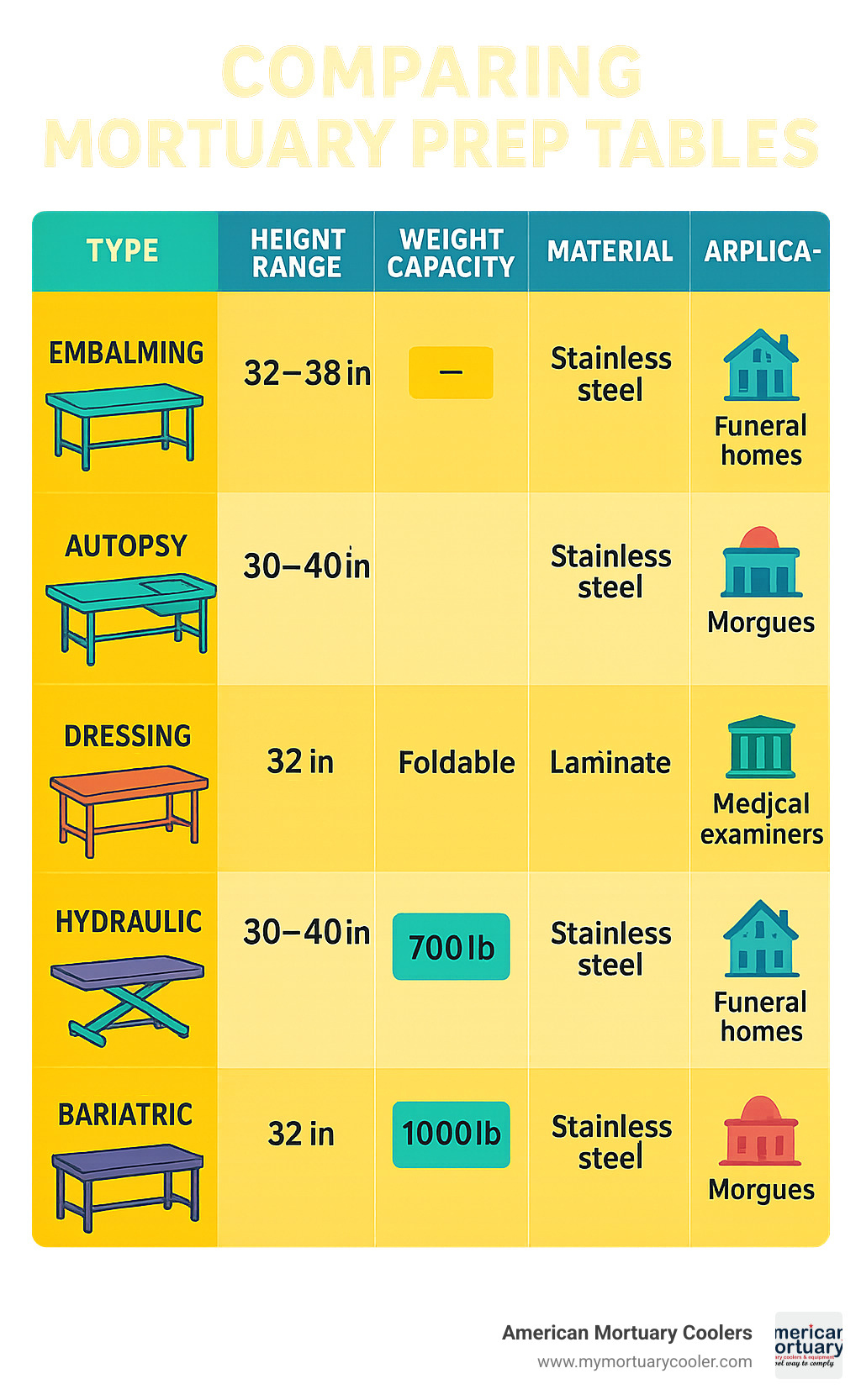
Mortuary prep table word guide:
Mortuary Prep Table Basics: Function & Anatomy
When you walk into a preparation room, the mortuary prep table stands as the centerpiece of your operations. This isn't just any table – it's the dedicated workspace where you'll perform embalming, conduct autopsies, and prepare the deceased with dignity for their final viewing.
Unlike your kitchen counter or office desk, a mortuary prep table is thoughtfully engineered for the unique challenges of postmortem care. The beauty of these tables lies in their practical design that balances functionality with respect for both the deceased and the professionals doing this important work.
"I've seen funeral directors struggle with inadequate tables for years before finally investing in proper equipment," shares our lead designer at American Mortuary Coolers. "The difference in their daily comfort and efficiency is night and day."
At its core, your mortuary prep table manages fluids through a gentle slope that guides drainage away from work areas. Most quality tables feature a subtle incline toward either a perimeter trough or center channel, directing fluids to a designated collection point. This seemingly simple feature prevents messy spills and maintains a sanitary environment.
The gold standard in the industry is 304 stainless steel construction. This medical-grade material stands up to years of harsh cleaning chemicals while resisting corrosion and providing a non-porous surface that's easy to sanitize. This durability isn't just convenient – it's essential for meeting OSHA compliance standards for surfaces in contact with biological materials.
Your back will thank you for choosing a table with proper ergonomic height. The sweet spot typically falls between 30-38 inches, with adjustable models accommodating different staff members and procedures. This thoughtful design prevents the back strain and fatigue that can come from hours of leaning over an improperly sized workspace.
Key Components at a Glance
Understanding the anatomy of your mortuary prep table helps you make smarter comparisons when shopping:
The frame provides the foundation, typically built from welded stainless steel tubing designed to support between 600-1,000 pounds. This unseen but critical component determines the overall stability and longevity of your investment.
The tabletop is your actual working surface, featuring either solid or perforated designs. While perforated tops offer superior drainage, solid surfaces can be easier to clean thoroughly. Both styles typically incorporate a subtle convex shape to guide fluids toward drainage channels.
A tilt latch mechanism allows you to adjust the head elevation during arterial injection or to facilitate better drainage. This simple feature can significantly improve your workflow during embalming procedures.
The drain outlet, usually positioned at the foot end, connects to standard plumbing (typically 1.5" diameter) or portable collection systems. This critical component ensures proper disposal of fluids in compliance with local regulations.
Finally, the swivel wheels with individual locks provide mobility when needed and stability when in use. Stationary models might instead feature adjustable feet for leveling on uneven floors.
"When I'm helping funeral homes upgrade their prep rooms," notes our equipment specialist, "we focus on these core components because they directly impact daily comfort and long-term satisfaction. A quality table becomes an extension of your professional skills."
At American Mortuary Coolers, we understand that the right mortuary prep table isn't just equipment – it's the foundation of your preparation room where care and craftsmanship come together to honor the deceased and provide families with meaningful closure.
The 6 Main Types Compared: Which Fits Your Facility?
Selecting the appropriate mortuary prep table requires understanding the distinct categories available and how each aligns with your facility's specific needs. Let's examine the six main types and their unique characteristics to help you determine which best suits your operation.
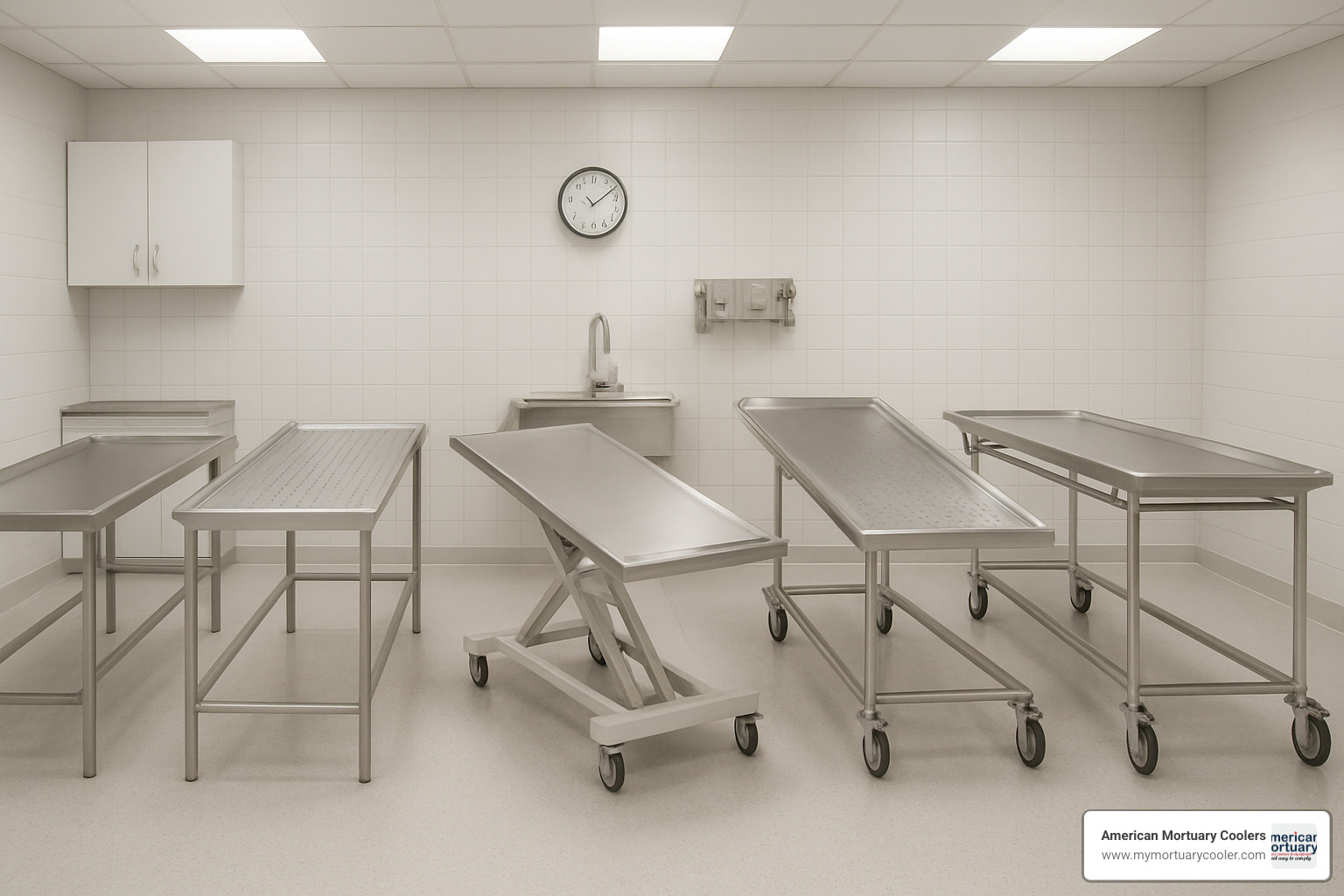
Embalming Mortuary Prep Table
When I visit funeral homes across the country, the embalming table is always the centerpiece of the preparation room – and for good reason. These workhorses are specifically engineered for the arterial and cavity embalming process that's at the heart of what you do.
What makes these tables special is their thoughtful design. The convex surface creates a gentle rise in the center that naturally positions the deceased and helps fluids run off toward the edges. Around the perimeter, you'll find a continuous trough that captures all those fluids and guides them to the drain outlet, typically positioned at the foot end.
"An embalming table is the foundation of any prep room," as one of our equipment specialists often tells clients. "We recommend models with a minimum 600-pound capacity and a perimeter trough depth of at least 1.5 inches to handle fluid volume effectively."
Most quality embalming tables measure between 32" x 80" to 35" x 85" – spacious enough for comfortable working while still fitting through standard doorways. And they're almost exclusively crafted from 304 stainless steel, which stands up beautifully to those harsh embalming chemicals while making disinfection a breeze.
Autopsy Mortuary Prep Table
Autopsy tables take preparation surfaces to another level, with specialized features designed for medical examination procedures. If your facility handles forensic cases or works closely with medical examiners, these tables offer capabilities that standard embalming tables simply don't have.
What immediately sets these tables apart are features like down-draft ventilation connections that reduce exposure to airborne pathogens – a significant health consideration for staff. You'll also notice integrated splash guards that contain fluids during dissection, mounting points for scales, and deeper sink basins that accommodate organ examination.
One particularly useful design element is the removable center drain plates that provide access to larger drain openings for more efficient fluid management. These tables aren't inexpensive – they range from $3,590 for basic models to $19,995 for advanced pedestal systems with integrated ventilation – but for facilities that need these capabilities, they're worth every penny.
"When selecting an autopsy table, consider your facility's case volume and the types of examinations you'll be conducting," our specialist typically advises. "For occasional use, a multi-purpose table with autopsy features may be more economical than a dedicated system."
Dressing & Folding Tables
After the embalming process is complete, that's when dressing tables come into play. These simpler surfaces are designed for final cosmetic preparation and dressing of the deceased, focusing on mobility and space efficiency rather than drainage features.
The beauty of these tables lies in their practicality. Most feature a space-saving folding design that's perfect for smaller preparation rooms where every square foot counts. With laminated or solid surface tops (no drainage systems needed for these dry procedures), they provide a clean workspace that's easy to maintain.
While lightweight – some weighing just 68 pounds – these tables are surprisingly sturdy, typically supporting up to 600 pounds. When not in use, they fold flat to about 13" depth, allowing them to be stored against a wall or even in a closet.
"Folding tables have become increasingly popular, especially for smaller funeral homes with limited space," notes our equipment specialist. They're also quite affordable, with quality options starting around $895 and ranging to approximately $2,145 for premium versions with improved features.
Hydraulic Mortuary Prep Table
If you've ever experienced back pain after a long day of embalming, you'll appreciate why hydraulic tables are worth considering. These represent the gold standard in ergonomic design, offering height adjustment that can make a world of difference for your comfort.
The star feature here is the pedestal lift system that provides smooth elevation changes, typically in the 30-38 inch range. This adjustability accommodates different operators and procedures without compromising stability. Depending on your preference, you can choose foot pump operation (keeping your hands free during procedures) or electric controls for effortless adjustment.
"The investment in a hydraulic table pays dividends in staff comfort and efficiency," as we often explain to clients. "For high-volume facilities where embalmers spend many hours at the table, the ergonomic benefits can prevent repetitive strain injuries and extend careers."
While hydraulic embalming tables represent a higher initial investment – ranging from approximately $2,885 to $5,194 – the long-term benefits for staff well-being make them worth considering, especially if you handle a high volume of cases.
Refrigerated & Viewing Tables
Combining temporary preservation with presentation features, refrigerated tables serve a dual purpose that many funeral directors find invaluable. These sophisticated units maintain temperatures between 36-42°F while offering a dignified presentation for family viewings or identifications.
What makes these tables special is their integrated chilling system paired with a tempered glass viewing lid that allows visual identification without exposure. The drainage systems are discreetly hidden but still accessible for cleaning, and the overall aesthetic is more finished – appropriate for family viewing situations.
"Refrigerated tables are particularly valuable for facilities without dedicated cooler rooms or those frequently conducting identification viewings," our specialist points out. They're especially useful in facilities with space constraints or those looking to expand capabilities without major renovations.
These specialized tables typically start at around $5,000 and can exceed $15,000 for models with advanced features like UV sanitization and digital temperature monitoring systems – a significant investment, but one that adds considerable flexibility to your operation.
Bariatric & Custom Builds
As America's population changes, so do the needs of funeral homes. Bariatric mortuary prep tables address the growing need for equipment that can safely and respectfully accommodate larger individuals.
These reinforced tables feature improved weight ratings supporting up to 1,000 pounds, with oversized dimensions (tops up to 42 inches wide) that provide appropriate space. To handle this increased capacity, they incorporate reinforced cross-bracing and heavy-duty casters with higher weight ratings.
"Bariatric cases present unique challenges that standard equipment simply cannot handle safely," explains our specialist. "We've seen a significant increase in orders for tables with 750+ pound capacities in recent years, reflecting changing demographic needs."
At American Mortuary Coolers, we specialize in custom-built solutions that match your specific requirements. Whether you need unusual dimensions, special features, or weight capacities beyond standard offerings, our team can design and build a table that fits your facility's exact needs. It's one of the advantages of working with a company that builds its products right here in the USA.
Buying Guide: Materials, Weight Capacity, Mobility & Price
When investing in a mortuary prep table, understanding the relationship between materials, specifications, and price points helps funeral professionals make informed decisions that balance quality with budget constraints.
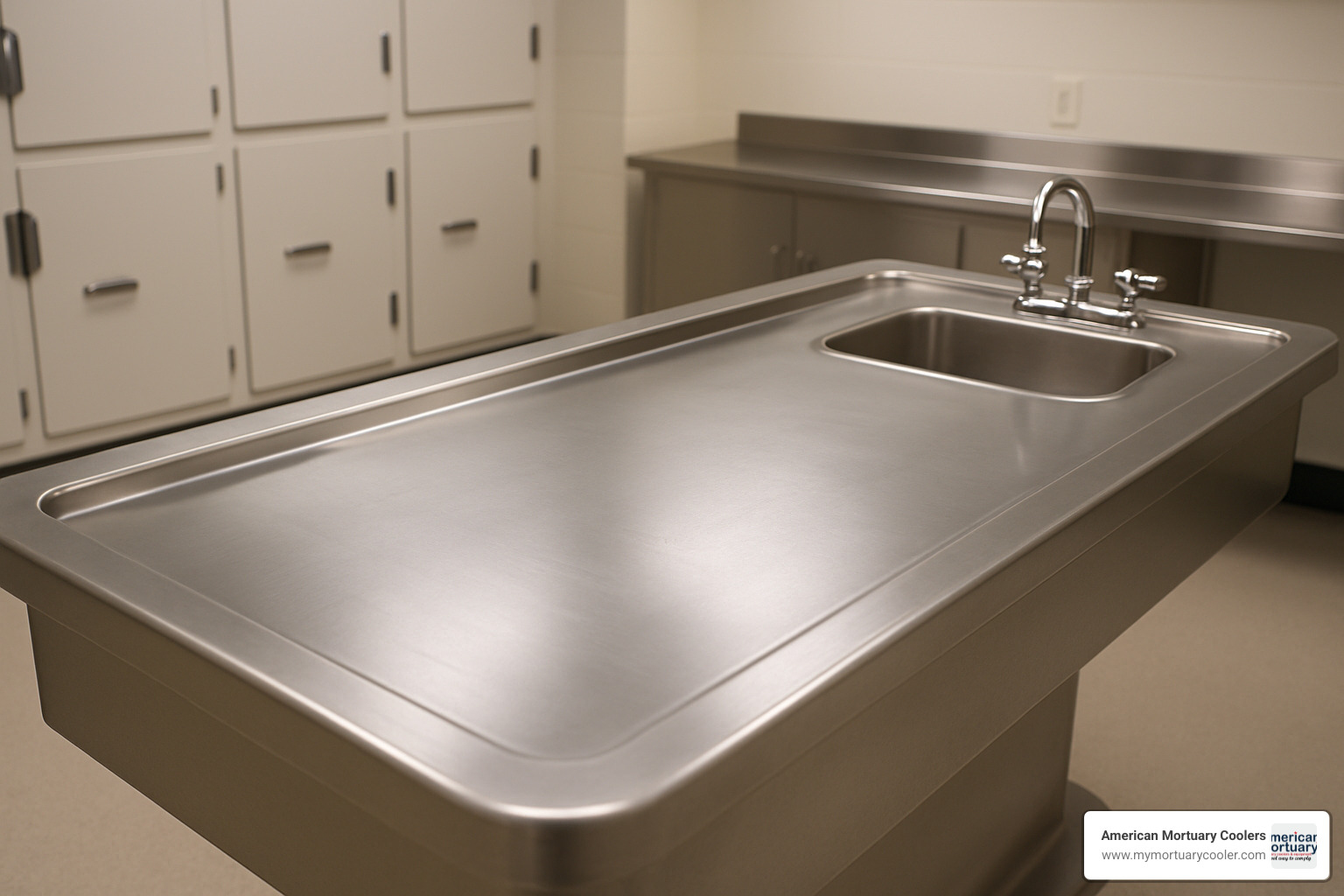
Why Stainless Steel Dominates
Let's talk about why stainless steel has become the superstar of the prep room world. It's not just about looking professional—though it certainly does that too!
"I've seen tables from the 1980s still in service," shares one of our equipment specialists at American Mortuary Coolers. "That's the magic of quality stainless steel—it's practically immortal in prep room years."
304 stainless steel contains about 18% chromium and 8% nickel, creating a self-healing protective layer that stands up to the daily assault of bodily fluids, embalming chemicals, and harsh disinfectants. For funeral homes near salt water or those using particularly aggressive chemicals, 316 stainless steel adds molybdenum for extra protection, though it comes with a 15-20% price premium.
Some budget-conscious funeral directors consider aluminum frames with stainless tops or laminate surfaces for dressing tables. While these alternatives might save you 30-40% upfront, they often tell a different story a few years down the road. The initial savings frequently evaporate with earlier replacement costs and maintenance headaches.
Understanding Drainage Systems
A thoughtfully designed drainage system isn't just a nice feature—it's the unsung hero of your prep room that prevents those "oops" moments from becoming major problems.
The best mortuary prep tables feature a subtle convex slope that naturally channels fluids toward drainage troughs. These can run along the perimeter or down the center, depending on the table design. Standard drain outlets (typically 1.5" diameter) connect seamlessly with most plumbing systems.
"I always tell new funeral directors to look closely at the drainage design," our specialist notes with a knowing smile. "It's like buying a house—you don't think about the gutters until there's water in your basement."
Premium tables feature precision-welded seams that create watertight barriers, preventing fluids from infiltrating the table structure. Budget options might use sealants that break down over time, leading to odor issues and potential structural damage that no amount of disinfectant can fix.
Mobility & Storage Options
Today's funeral homes often need to do more with less space, making mobility features increasingly valuable.
"One of our customers in New York operates in a building from the 1890s," shares our equipment specialist. "Their prep room doubles as storage when not in use, so their folding table has been a game-changer for them."
Modern mortuary prep tables offer clever mobility solutions like swivel casters with individual locks for repositioning between cases. Some models feature directional wheels that can be set to track straight—particularly helpful when moving down long corridors.
For the ultimate in space efficiency, folding tables like our MOBI Folding Dressing Table transform from a full-sized 77" × 25" × 34" professional surface to a slim 59" × 25" × 13" profile that can tuck against a wall or even hang on specially designed wall brackets.
Height-adjustable legs aren't just about ergonomics—they're also practical for dealing with uneven floors in older buildings, ensuring your table remains rock-solid during procedures regardless of your facility's quirks.
Budget Snapshot: Entry vs Hospital-Grade
Let's be honest—budget matters. But understanding the full spectrum of options helps you make an investment that makes sense for your unique situation.
Mortuary prep table prices range dramatically based on construction quality, features, and capabilities:
Entry-level folding tables start around $895, offering basic functionality for smaller facilities or those with occasional needs. At the other end of the spectrum, hospital-grade pedestal autopsy systems can reach $19,995, with all the bells and whistles needed for medical examiner facilities.
In between, you'll find standard fixed-height embalming tables ($1,500-$2,500), mid-range hydraulic embalming tables ($2,885-$5,194), and premium autopsy tables ($3,590-$12,000).
"I always encourage funeral directors to think about cost per year rather than sticker price," our specialist advises warmly. "A $4,000 table that serves you faithfully for 20 years costs just $200 annually—less than your coffee budget!"
Don't forget to consider valuable accessories that improve functionality: side rails for secure body positioning, head blocks for stability during embalming, and side extensions that increase your working surface. These typically add $75-$500 depending on their complexity.
At American Mortuary Coolers, we understand that cash flow matters to small businesses. That's why we offer financing options that help funeral homes acquire professional-grade equipment without straining their operating capital. Many of our clients find that the time saved and stress avoided with quality equipment actually pays for the monthly payments through improved operational efficiency.
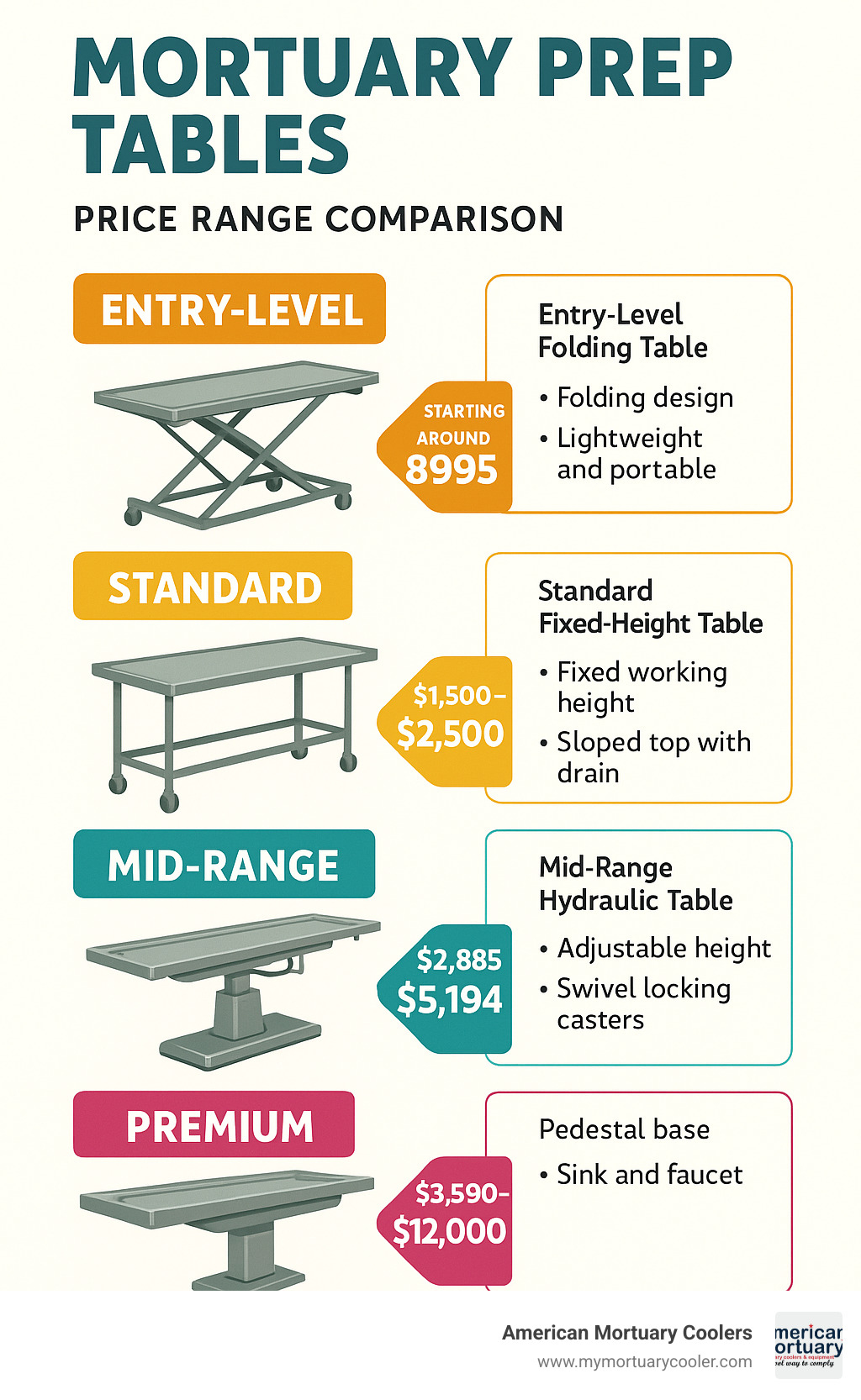
Cleaning, Maintenance, Cultural & Safety Considerations
Keeping your mortuary prep table in top condition isn't just about extending its lifespan—it's about showing respect for the deceased and creating a safe environment for your staff. With proper care, a quality table can serve your facility for decades while maintaining compliance with health regulations.
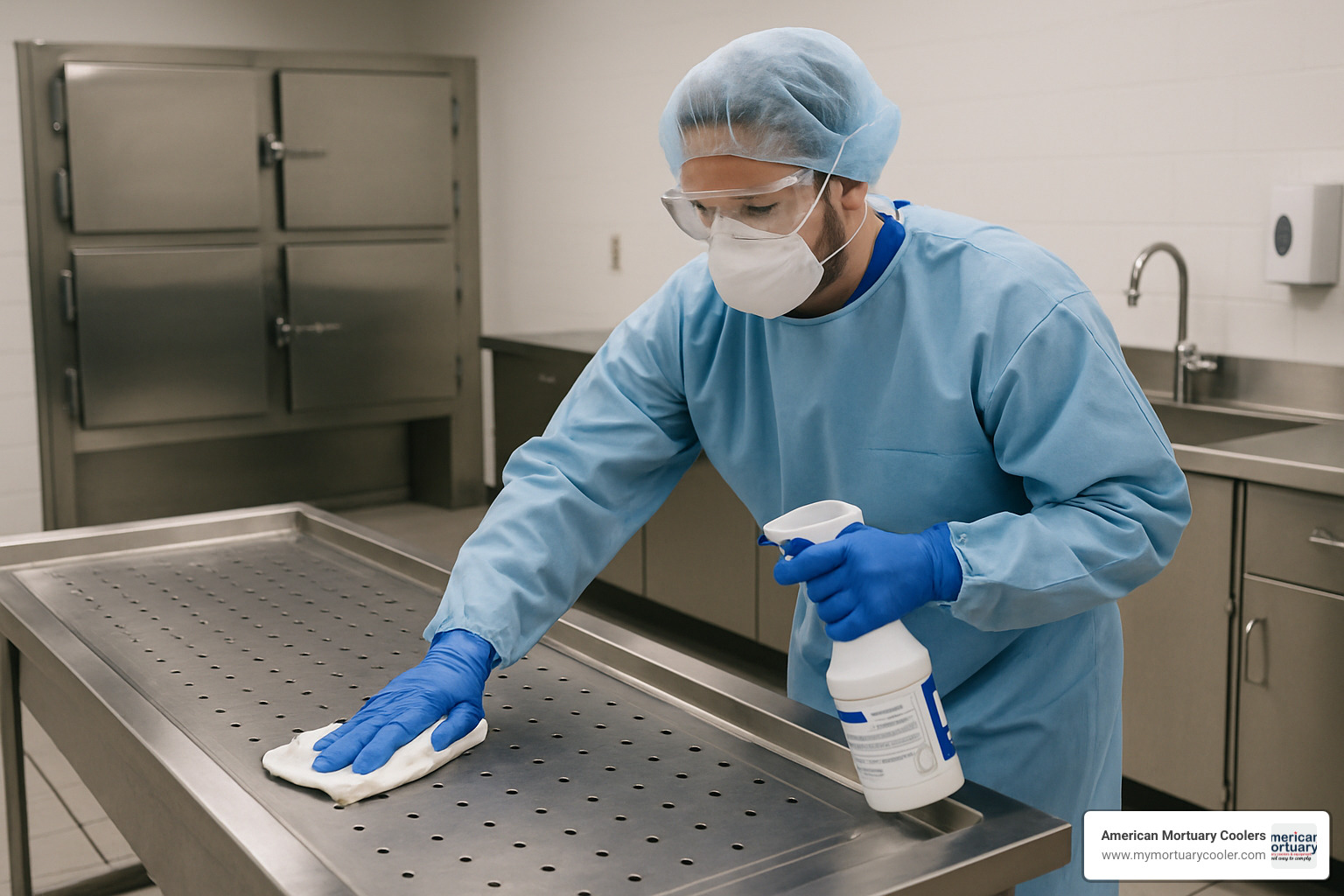
Daily & Weekly Cleaning Checklist
"You know, I always tell folks that cleaning a prep table is like brushing your teeth—skip it once and you might be fine, but make it a habit and you'll avoid serious problems down the road," shares our maintenance specialist at American Mortuary Coolers.
After each procedure, start by thoroughly rinsing the mortuary prep table with warm water to remove visible residues. Follow up with a neutral pH cleaner specifically designed for stainless steel—harsh chemicals can damage the protective oxide layer that makes stainless steel so valuable.
Next comes disinfection, which isn't optional in our industry. Apply an EPA-registered disinfectant that's proven effective against bloodborne pathogens. The key here is patience—let the product sit for the full contact time recommended by the manufacturer. Many people rush this step, which significantly reduces effectiveness.
Before finishing, give your mortuary prep table a final rinse to remove chemical residues that could cause corrosion over time. Then dry it completely—standing water is the enemy of stainless steel and can lead to spotting and bacterial growth.
On a weekly basis, take a few extra minutes to inspect the drainage system for clogs, lubricate hinges and adjustment mechanisms, and test all locking features. This quick check can prevent bigger problems later.
"I've seen UV-C sanitizing wands become popular supplements to chemical cleaning," notes our specialist. "They're great for those hard-to-reach spots like drainage channels, though they don't replace good old-fashioned elbow grease and proper disinfectants."
Long-Term Maintenance Tips
Even the finest mortuary prep table needs regular attention to stay in prime condition. Every three months, make time for a deeper maintenance check. For hydraulic tables, inspect fluid levels and watch for leaks—a small issue today can become a big repair bill tomorrow.
Don't forget about the wheels! Clean the caster housings and apply lubricant to keep them rolling smoothly. It's also smart to use a narrow brush to clean drain lines, preventing the buildup of biofilm that can cause odors and slow drainage.
"One thing people often overlook is checking the actual surface of the table," our maintenance expert points out. "Run your hand along the steel and look for early signs of pitting or corrosion. Catching these issues early can save you from premature replacement."
Once a year, consider having a professional inspect hydraulic systems, replace any worn gaskets, and examine all welded joints. This annual service typically costs between $200-$400 but can add years to your table's useful life.
We suggest keeping a simple maintenance log noting when services were performed and by whom. This documentation isn't just helpful for planning—it may be required during regulatory inspections. For our hydraulic tables, we recommend fluid replacement every 3-5 years to ensure smooth operation and prevent system degradation.
Adapting Tables for Cultural Needs
America's diverse communities bring varied traditions and requirements to funeral service. A well-designed mortuary prep table should accommodate these needs with dignity and respect.
Some religious traditions prefer specific positioning during preparation—for example, an east-west orientation. Others require continuous coverage of the body with linen barriers during the preparation process. Many faiths limit physical contact or specify who may participate in preparation.
"I remember helping a funeral director who serves a large Muslim community," recalls our specialist. "He needed a table that could accommodate ritual washing with continuously flowing water while maintaining proper drainage. With some minor adaptations, we created a solution that perfectly respected these sacred traditions."
The adjustable head elevation feature found on many of our tables proves particularly valuable for facilities serving multiple faith traditions. Instead of improvising with props that might compromise dignity, the table itself can be configured appropriately for different preparation requirements.
Safety Considerations for Staff and Decedents
A well-designed mortuary prep table protects both the professionals providing care and the deceased entrusted to that care. For staff, ergonomic working height is crucial—tables that are too low or too high can cause serious back strain during lengthy procedures.
Look for tables with smooth, rounded edges that won't tear protective clothing or cause injuries. Locking systems should engage securely and hold the table firmly in place during procedures. Weight capacity indicators should be clearly marked and never exceeded, even for temporary lifts.
"Safety isn't just about avoiding injuries—it's about creating confidence in your movements," explains our specialist. "When you're not worried about a wobbly table or failing locks, you can focus completely on providing dignified care."
For the deceased, consider features like optional padded surfaces that prevent pressure marks on delicate skin. Secure positioning features prevent accidental shifting during procedures, while gentle inclines facilitate drainage without compromising dignity.
For bariatric cases, specialized lifting equipment that works with your table is essential for safe transfers. At American Mortuary Coolers, we design compatible lifting systems specifically to integrate with our reinforced tables, protecting everyone involved during these challenging movements.
Safety extends beyond the table itself to its placement within your preparation room. Ensure adequate space around all sides for comfortable movement, provide excellent lighting, and keep safety equipment easily accessible.
With thoughtful maintenance, cultural sensitivity, and safety awareness, your mortuary prep table will remain the reliable centerpiece of your preparation room for years to come.
Frequently Asked Questions & Conclusion
After exploring mortuary prep tables together, I've noticed several questions that come up repeatedly when funeral directors are shopping for new equipment. Let's address these common concerns with straightforward answers:
Do I Need a Hydraulic Mortuary Prep Table for a Small Funeral Home?
This is perhaps the most common question I hear from smaller funeral homes. While hydraulic tables offer wonderful back-saving benefits, they're a significant investment that might not make sense for everyone.
"I was on the fence about a hydraulic table for our 85-calls-per-year funeral home," one director told me recently. "But after factoring in my embalmer's recurring back pain, it became an easy decision."
Consider your specific situation:
If you handle fewer than 100 cases yearly, the return on investment might take longer to realize. However, if your staff includes embalmers with back issues or if they're approaching retirement age, the ergonomic benefits might outweigh the cost considerations. The $1,500-$2,500 premium over standard tables is substantial, but spread over a 15-20 year lifespan, it becomes more reasonable.
For smaller operations with budget constraints, a high-quality fixed-height table paired with good anti-fatigue mats and adjustable stools can create a comfortable working environment without the hydraulic price tag. Another middle-ground option is a multi-height table with manual adjustment capabilities, offering some flexibility at roughly half the cost of hydraulic systems.
What Weight Capacity Is Best for Bariatric Cases?
With approximately 42% of American adults now classified as obese and about 9% experiencing severe obesity, weight capacity has become a crucial consideration for mortuary prep tables.
Standard tables typically handle up to 600 pounds, which was sufficient for most cases a decade ago. Today, however, I recommend at least one table with a 750-pound capacity for most funeral homes. For facilities in regions with higher obesity rates, specialized bariatric tables supporting 1,000 pounds or more provide necessary security.
"We didn't think we needed a bariatric table until we had three cases exceeding our standard table's capacity in a single month," shared a funeral director from the Midwest. "Now our heavy-duty table gives us peace of mind and shows respect to all families we serve."
Beyond just respecting the dignity of larger individuals, appropriate equipment protects your staff from injury and your business from liability risks associated with equipment failure. It's an investment in both compassionate service and workplace safety.
How Often Should Drainage Lines Be Sanitized?
Drainage maintenance is one of those unglamorous tasks that's easy to overlook—until you're facing odors, contamination, or worse, a complete blockage during a procedure.
A good maintenance schedule includes:
After each use, flush the system thoroughly with plenty of water to remove residues. Weekly, clean with an appropriate drain cleaner and disinfectant to prevent buildup. Monthly, use drain brushes for mechanical cleaning, especially in bends and traps. And quarterly, consider having your main drain lines professionally serviced.
For tables with removable drain covers, make a habit of inspecting and cleaning the drain trap regularly. This five-minute task prevents hours of frustrating downtime and emergency service calls that always seem to happen at the worst possible time.
"One of our new apprentices asked why I was so particular about drain maintenance," a preparation room manager told me. "Two weeks later, when our competitor across town had to reschedule three embalmings due to a backed-up drain, he understood completely."
Selecting the right mortuary prep table is about finding that sweet spot where durability, functionality, ergonomics, and value align with your specific needs. It's an investment not just in equipment, but in your staff's wellbeing and the quality of service you provide to families.
At American Mortuary Coolers, we understand that every funeral home has its own unique requirements based on facility layout, case volume, and community demographics. Our team in Tennessee takes pride in helping funeral professionals throughout the continental United States find solutions that truly fit their needs—not just selling catalog items.
Whether you're setting up a new preparation room or upgrading existing equipment, we're here to offer guidance based on our experience equipping hundreds of funeral homes nationwide. Our insights go beyond product specifications to practical, real-world applications that ensure you select a mortuary prep table that will serve you faithfully for years to come.
For more information about embalming tables, folding dressing tables, and other mortuary equipment, visit our blog for detailed guides and industry insights.
















